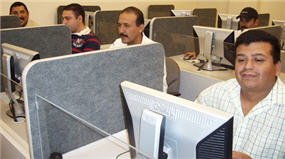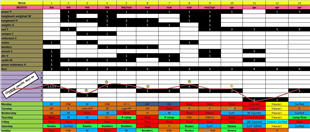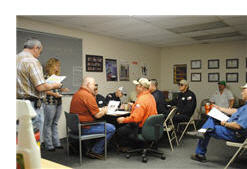Making Sure Your Training Program Succeeds
 A Plastics Training Checklist
A Plastics Training Checklist
After your company has made an investment to introduce structured training to your team. Where exactly do you start so that you get the most out of your training program?
The lack of a training implementation plan will yield sub-optimal training results. While a structured, organized approach will help you get the most out of your training investment.
There is a reason that pilots use checklists. You don't want the folks up front missing a crucial step before take-off. Likewise, Scientific Molding demands a rigorous systematic approach to injection molding that documents everything and makes the molding process repeatable. Same hold true for Extrusion, Blow Molding, Compounding, Thermoforming, etc. Systems are the key.
So, that said, here is how you get a training program up and running successfully.
Plastics Training Checklist
Part 1 - Preparing For Training
Here are our suggested steps for preparing a successful launch of your training program:

- Assign a Training Supervisor - This person will be tasked with overall implementation of the training
- Announcement - Notify all participating employees that the training will be starting, Explain what it is, why the company is doing it, how the employees and the company as a whole will benefit
- Voluntary vs. Mandatory - This is a judgement call that needs to be made by management. Our experience is that starting with a voluntary approach is best. Why? People don't like to be told what to do. And in the case of training, the word will get out very quickly that the training is fun, educational and somewhat addicting. Personnel who may at first be reluctant will be swept up in the tide. We've seen this over and over
- Maintaining Training Schedule - How much training? We recommend one lesson per week, two at the most. Some employees will want to go faster. That's good, but study after study has shown that learning, then applying new knowledge, is the key to effecting lasting change. Explain that to anyone that wants to do a lesson a day (and you will have a few people like that). We strongly suggest enforcing this particular step
- Company Training Room - Prepare a designated area where your Paulson injection molding training will take place. This should be a place that is quiet and free from outside distractions. Strongly Recommended: DO NOT let trainees be interrupted while they are taking their weekly training lesson. Every company can run (or should be able to run) without and one employees for 60 to 90 minutes. If yours can't, you should address that bigger issue
- Tracking Results - Document the "Pre-Training State of the Production Floor" status. This will serve as a benchmark by which you can measure improvements. Some suggested metrics are downtime, mold change times, production output, cycle times, scrape or reject rates, etc. After a few months of training, you'll take these numbers and measure them against your new numbers to see where the training is having an impact and where you may need to address how to fine-tune your training program (we'll help you with this)
Part 2 - Day-To-Day Best Practices
Here are our suggested steps in starting the daily training of employees:

- What, Why and How - Reiterate to all employees who will be participating in the training the what, why and how of the initiative - What the training is, Why you are doing it and How you will be conducting the training.
- Pre-Training Assessment - Administer a "Pre-Training" Needs Analysis Assessment to all trainees. This is to establish a baseline of current processing knowledge in the plant. It is important to emphasize that this assessment is not a "test" and will not affect an employee's standing in the company.
- Begin Scheduled Training - Start the training based on the schedule that your assigned training supervisor has created. Initially, monitor training schedules a few days each week. Employees have to be held accountable. Our experience has been that once employees get started, they embrace interactive training and look forward to learning.
- Milestone Meetings - Approximately every 2 weeks, the Training Supervisor should meet with all trainees as a group (ideally groups of 10 or less) to discuss the training. Here's the short-list of some topics that might come up:
- Questions on subject matter in lessons as they relate to your company procedures
- The pace of the training (for some - too slow, others - too fast; adjust accordingly)
- If and how they are able to apply what they're learning directly on the job
- Any stories of specific improvements employees have experienced as a result of the training. This reinforces the overall training initiative and helps with "buy-in" from other employees.
- Scheduling difficulties or conflicts. If some employees are skipping their assigned training, this would be a good time to find out why.
- Managers/Supervisors should set up guidelines for how newly trained employees can apply what they have learned. At-the-machine competency assessments are a good way of doing this. This allows you to control the speed of implementation of new knowledge and avoid potentially safety issues or production errors, both large and small.
Part 3 - Post-Training Procedures
Here are suggested steps for you to follow after an employee has finished a full course:

- Post-Training Knowledge Assessment - This lets you to measure post-training knowledge and skill improvements on the production floor. We have a standardized on-line test that thousands of employees have taken. If you use our test, you'll be able to see how they stack up against the industry as a whole.
- Additional/On-Going Training - Most employees want to move forward with their training. Not everyone will fall into this category, but for those that have the ambition, by all means get them going on more advanced training.
- Refresher Training - Allow employees to repeat any training they want. People simply cannot retain 100% of what they learn the first time through any course. Regular "refresher" training sessions can only help. Plus, it keeps enthusiasm up among employees continuing on with training.
- After Training Assessment - If you followed the steps in Part 1 of the Implementing Plastics Training Checklist,
 youshould have a baseline of production metrics before any training was done. Now is the time (but no sooner than 6 months after the start of your training) to gather that same injection molding production data and compare it to the "Before Training" data. If employees have applied what they've learned in the previous 6 months, you will see dramatic changes. At your discretion, you may want to post some or all of this data so employees can feel a part of something very positive in the company that they played a significant role in.
youshould have a baseline of production metrics before any training was done. Now is the time (but no sooner than 6 months after the start of your training) to gather that same injection molding production data and compare it to the "Before Training" data. If employees have applied what they've learned in the previous 6 months, you will see dramatic changes. At your discretion, you may want to post some or all of this data so employees can feel a part of something very positive in the company that they played a significant role in. - On-Going Record Keeping - Put in place a system to monitor on-going productivity numbers and employee assessment scores. You want to see a nice steady upward slope in all area's (well, almost all... we'd like to see a steady downward slope in average cycle times).
That's it. Once the training system is in place, it should pretty much run on autopilot. And that is the key. Make it a system - another piece of the production process. Too many companies treat training as a sideshow or one-time "event". The fact of the matter is that training can actually be a leading role in your productivity and profits.



